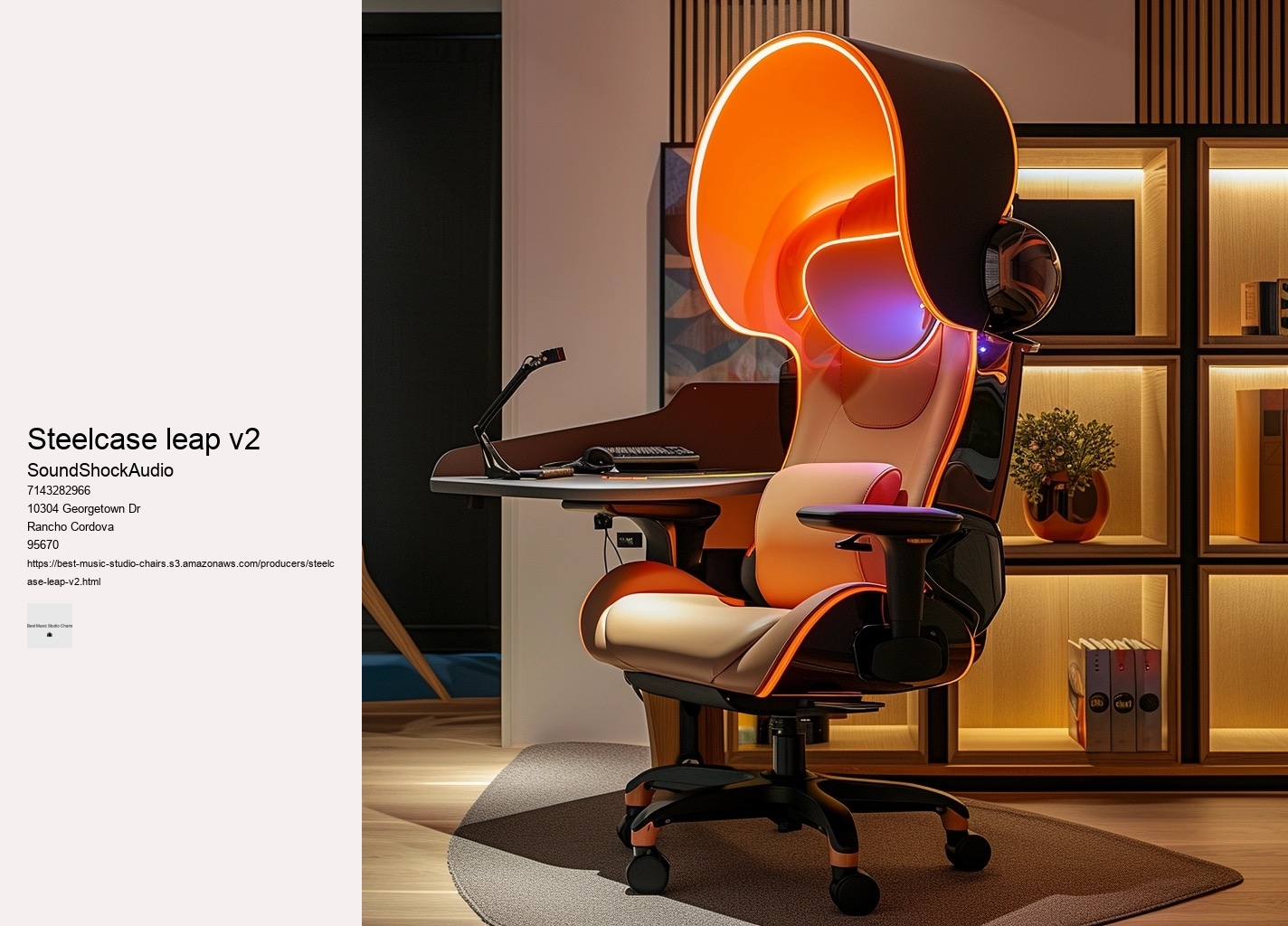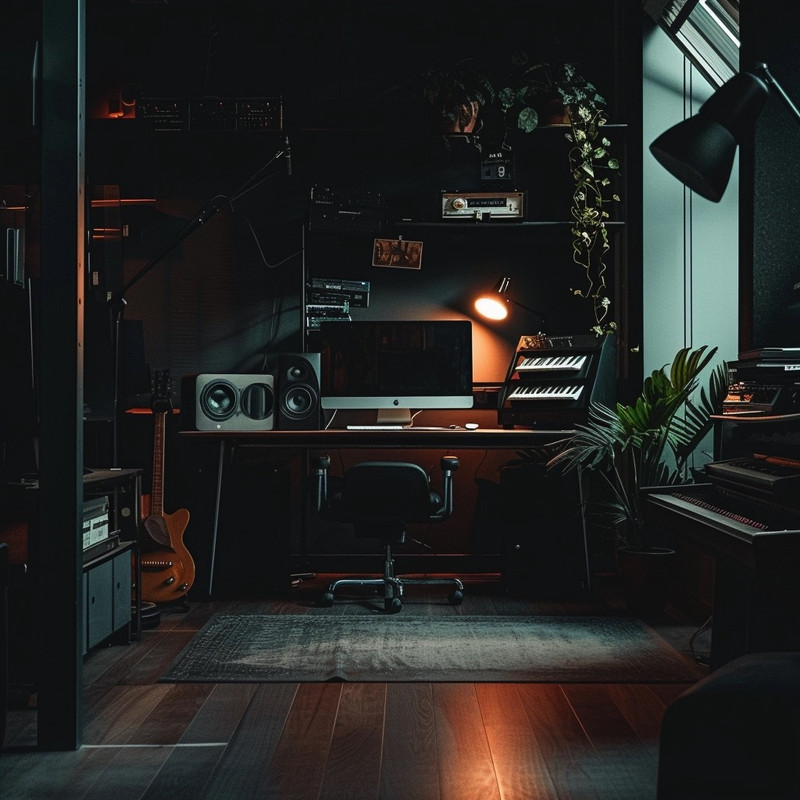

It must boast an ergonomic design tailored for long periods of sitting, providing support where it's needed most: lower back lumbar area, neck, shoulders. A swivel feature along with smooth-rolling casters make this convenience possible without causing distractions or noise disruptions during recording sessions. Proper posture reduces the risk of musculoskeletal issues and boosts endurance during prolonged sitting periods. Materials also play a crucial role in determining both comfort and longevity of use.
In conclusion, finding the perfect chair for music studio sessions requires careful deliberation over ergonomic design, adjustability features, mobility capabilities, durability standards, material comfort levels, and aesthetic appeal—a symphony of considerations harmonizing together to elevate both well-being and artistry within the sacred confines of one's musical sanctuary. Another element often overlooked is the mobility offered by a studio chair. Seat depth adjustment is another key element often overlooked but equally vital for tailored thigh support without cutting off circulation behind the knees – especially important for taller or shorter individuals who may need more or less space than what standard non-adjustable chairs offer.
But simply owning an ergonomic chair isn't enough; you must also be mindful of how you use it. Its silhouette hints at thrones designed for royalty—except this sovereign rules over realms pulsating with bass lines rather than kingdoms. leather
In conclusion, investing in an ultimate comfort chair for your studio sessions pays dividends in well-being and work output. Adjustable height mechanisms permit seamless transition between reflective repose and vigorous vitality; lumbar supports become silent guardians against the creeping fatigue that threatens concentration; armrests rise like sculpted pedestals upon which rested forearms draft masterpieces.
The silhouette of a studio chair also communicates much about its character: whether it's minimalist lines that echo modernist sensibilities or more ornate structures that nod to classical influences. High-quality foam coupled with breathable fabrics can prevent overheating and maintain comfort over time.
Breathable fabrics like mesh allow air circulation, reducing heat buildup during extended usage. A chair should offer versatile adjustments – from seat height and tilt to lumbar support and armrest positioning – ensuring that it can conform to various body types and preferences. Adjustable in every sense, from armrest height to lumbar support tension, this chair adapts to you rather than demanding your adaptation to it. Beneath this marvel lies a foundation sturdy yet silent: wheels glide across studio floors as if skating on ice untouched by Zamboni's grace.
Choosing between budget-friendly and high-end options depends on multiple factors like financial constraints, duration of use per day, and personal priorities regarding health and comfort. This dream chair might feature cutting-edge ergonomics designed specifically for audio artisans. Consider materials as well: breathable meshes ensure ventilation during summer's sweltering assaults; meanwhile, supple leathers provide warmth when winter weaves its chilling tapestry across studios.
By investing wisely in durable seating solutions today, musicians can secure their comfort and focus on what truly matters: creating great music without interruption due to faulty furniture tomorrow. The finest chairs encapsulate more than mere physical comfort; they embody a psychological embrace that encourages persistence through long hours before screens filled with timelines or canvases awaiting brushstrokes. These chairs offer adjustable features such as lumbar support that molds to the contours of your spine, armrests that align with your natural posture, and seat pans that encourage circulation even after hours of being seated.
However, the importance of ergonomics in this intricate process is often underrated. In conclusion, while whimsical furniture pieces may spark temporary intrigue or amusement among musicians seeking uniqueness within their space, ultimately they fall short compared to professionally tailored solutions when aiming to unlock one's full music potential. Thirdly, mobility within the workspace enhances efficiency and keeps creative juices flowing.


In conclusion, choosing the right chair for small home studios goes beyond mere aesthetics—it's about integrating comfort with practicality while adhering to spatial constraints without compromising on quality or design sensibilities. The quest for the perfect studio chair resembles searching for a needle in a haystack. As we delve into finding the best chairs for enduring studio sessions, we'll consider key features that contribute to a supportive seating experience.
The synthesis between advanced design philosophies and cutting-edge material science births chairs that endure not just physical stress but also trends' evanescence. Your chair does not exist in isolation but amid an ecosystem of gear and decor—it should inspire just as much as it supports.
Setting aside time for short breaks where you stand up, stretch out or walk around is crucial for maintaining back health over longer stretches of time. Next time you embark on an auditory odyssey of mixing or mastering music tracks remember—a great studio chair doesn't just keep you seated; it keeps you seamlessly integrated into the heartbeats of melodious precision for countless hours on end.
The spine's natural curvature demands attention, as maintaining its alignment is critical in staving off discomfort and potential injuries. Thus arises the question – what constitutes the best studio chair?
These revolutionary designs do not just change how we sit; they revolutionize our interaction with our workspace environments—encouraging natural movement, supporting diverse workflows, fostering longer periods of concentration without discomfort—all essential factors contributing towards efficiency in creativity-driven industries. Its innovative backrest aligns seamlessly with the spine's natural curve, promoting an upright position without strain. In conclusion, while losing ourselves in music production can be deeply satisfying both creatively and professionally, it's vital not just for our art but also for our physical health that we pay attention to what our backs might be missing out on during those long mixing sessions: movement variety; ergonomic support tailored specifically towards us as individuals; periodic rests allowing recovery times between intense focuses; plus ongoing maintenance through targeted exercises outside studio walls alongside professional therapeutic interventions when needed.
Moreover, mobility is another important feature of a good studio chair. Music producers often spend prolonged periods seated while mixing or mastering tracks.
For professionals embarking on long sessions within their studios, a chair is not merely a place to sit; it is a tool that can either enhance or diminish one's productivity and well-being. Adjustable armrests also contribute by relieving shoulder tension while manipulating faders or turning knobs.
This offers mobility and flexibility, letting you glide across your studio space without missing a beat. Here's an unconventional guide to finding a chair that hits all the right notes.

It should withstand regular use without degrading in function or appearance. This will create a quirky and unusual text that maintains the essence of the topic but with a twist.---When we delve into the realm of studio furniture, particularly chairs designed for music producers, durability stands as a paramount attribute. These tactile choices are paramount in sustaining focus when external conditions fluctuate with whimsical abandon.
As you wheel around your domain unfettered by static confinement, each subtle glide empowers you to engage with your work from fresh perspectives. In specialty markets, chairs like Secretlab's Titan series cater explicitly to users who require exceptional stability alongside customizable features such as adjustable lumbar support pillows and 4D armrests – perfect for tailoring to one’s individual needs during long mixing or editing periods. Lumbar
Investing in such specialized furniture demonstrates not only a commitment to one’s craft but also self-care. They say silence speaks volumes; here it underlines productivity free from unnecessary interruption—a testament to thoughtful design embracing virtue of stealth.
Alternatively, memory foam padding can offer additional pressure relief and custom comfort that adjusts as you move. The armrests should allow your shoulders to relax without slouching.2.
Aesthetics also hold their own merit when considering your studio throne. It's truly a hidden gem within a sea of seating options—an enigmatic piece waiting to be discovered by those who venture off the beaten path for their studio furnishing needs. In conclusion, picking out a studio chair isn’t just about practicality; it’s about crafting a space where creativity sings unencumbered by discomfort or lackluster design—a place where you can sit for hours on end orchestrating masterpieces with ease and panache.
Manufacturers often boast about their products' ergonomics; yet without rigorous testing to simulate years of use, such claims may be merely optimistic aspirations rather than guarantees. As such, they invest in high-quality chairs engineered specifically to address the demands of their profession.
Another outstanding option is the Steelcase Leap Chair. Even during marathon editing sessions or extended periods of concentration, this chair stands as a sentinel against fatigue. stealth
The human body is an intricate organism that thrives on movement and variability. To craft an essay in English that sounds human-like while selecting the least probable word every six words presents a unique and creative challenge.
Whether Aeron is better than Embody depends on individual preferences and needs. The Aeron chair, designed by Herman Miller, is renowned for its ergonomic design and breathable mesh fabric, making it a popular choice for long hours of use. The Embody chair, also by Herman Miller, is designed with a focus on supporting the back and promoting good posture, featuring a more adaptive and dynamic support system. Ultimately, the choice between Aeron and Embody should be based on personal comfort, the specific ergonomic features that best suit your body, and aesthetic preference.
Yes, expensive office chairs can make a significant difference, especially in terms of ergonomics, comfort, and durability. They are often designed with better materials and advanced features to support posture, reduce back pain, and enhance overall productivity by making it easier to sit for long periods. However, the value of an expensive chair depends on individual needs and how well the chair's features align with those needs.
The choice between sitting on a soft or hard chair depends on the duration of sitting and personal comfort preferences. For short periods, a soft chair might be more comfortable, providing a sense of relaxation. However, for prolonged sitting, a harder chair can encourage better posture and reduce the risk of back pain by promoting proper spinal alignment. Ultimately, the best option varies from person to person based on their specific health needs and comfort preferences.
Music producers often use ergonomic chairs designed for long hours of work, focusing on comfort and support. Popular choices include the Herman Miller Aeron and the Steelcase Leap, which offer adjustable features to fit a wide range of body types and preferences. These chairs help in reducing fatigue and increasing productivity during the extensive periods spent mixing and mastering tracks.